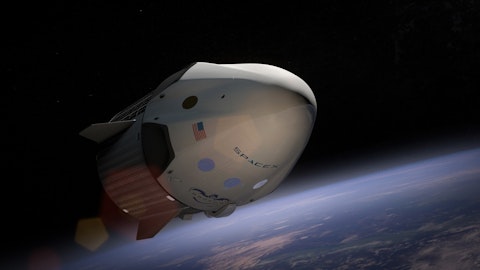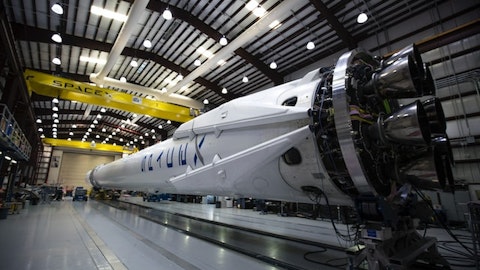In this article, we will discuss the 15 Biggest Airplanes in the World in 2023. You can skip our industry overview and go directly to the 5 Biggest Airplanes in the World in 2023.
On December 17th, 1903, the age of modern aviation was born when brothers Orville and Wilbur Wright made the first successful flight in the history of mankind. Since then, we have witnessed some incredible milestones, including the development of the jet engine, and the breaking of the sound barrier in the SR-71 Blackbird, to name just a few. From the massive Zeppelin bombers of World War I to the wooden planes of the 1940s all the way through to today’s wonders of science and engineering, airplanes have gone from small and agile machines powered by propellors to heavy behemoths launched thousands of feet into the air by turbofan jet engines. The world’s first-ever jumbo jet, the Boeing 747, was constructed by The Boeing Company (NYSE:BA) in 1970. Over 50 years later, the airline industry is considered saturated by wide-body aircraft, with the likes of the Airbus A380, the Antonov AN-225, and the Hughes H-4, alongside others, vying for the title of the ‘biggest’.
While these giants of aviation, symbols of humanity’s progress across the ages, never cease to amaze, they had almost entirely been replaced by their smaller competitors until very recently. Even before the pandemic temporarily shut down most air travel, airlines had been shying away from the biggest wide-body planes in favor of smaller twin-aisles, or longer-range narrow-body jets, believing that they offered more flight flexibility alongside better fuel economy. At the height of the pandemic, the shift toward smaller planes intensified, resulting in several airlines either deferring or outright canceling orders for twin-aisle planes and moving to permanently park the biggest jets, including dozens of Boeing 747s and Airbus A380s.
Admittedly, large planes are still short of making a comeback, as evidenced by The Boeing Company (NYSE:BA) rolling out its last 747 jumbo jet on December 6, 2022, more than half a century after production of the plane began. Although many such planes are still in use, this last delivery reflects a growing industry shift from bulky four-engine planes to more cost-efficient twin-engine models. Additionally, as illustrated by a report by the Wall Street Journal, the total number of flights operated on twin-aisle jets in January of this year came in at only 76% of the total flown in the same month in 2020. By all accounts, the aerospace industry seems pressurized due to these developments.
However, a report by the Business Research Company states that the global aerospace market grew from $261.12 billion in 2022 to $278.43 billion in 2023, with the market expected to further reach $358.44 billion in 2027 at a CAGR of 6.5%. The industry seems to be betting on pent-up travel demand from China after it dropped most of its travel restrictions as part of its zero-COVID policy. The return to the skies of bigger aircraft appears to be driving new sales and campaigns for both The Boeing Company (NYSE:BA) and Airbus after years of slumping demand. This past year, the two airline company’s reported 301 gross orders for their wide-body jets. Additionally, Boeing and Airbus sales staff are chasing after several big orders for new planes from carriers and lessors in order to compensate for the increased demand for wide-body planes.
Meanwhile, the scramble for big planes has overturned conventional wisdom in the aviation industry as several airlines are clamoring for their once-parked fleets of giants, which typically each accommodate hundreds of passengers on long-distance routes. According to John Plueger, chief executive officer of Air Lease Corporation (NYSE:AL):
“There has been a tremendous acceleration in the last eight to 12 months in the wide-body marketplace.”
Of course, among all the unrest and uncertainty, as can be said for all feats of technical innovation, the quest to build the biggest, longest, or heaviest goes on.
Our Methodology
With regards to aircraft, ‘big’ is a subjective matter, as there are many ways to measure large aircraft – including length, weight, volume, or wingspan. While we’ll take all of these factors into consideration, it should to noted that some of the airplanes mentioned in this list all have different metrics that can technically make them the largest aircraft in the world depending on which metric you choose to focus on. To provide our readers with more clarity and to come up with an accurate list of the biggest planes in the world, we sifted through the data and information provided by reputable sources, including CNN, Discovery UK, USA Today, and Plane and Pilot Mag, among others. Our rankings reflect the consensus opinion and rankings of these reliable sources.
Biggest Airplanes in the World in 2023
15. Aero Spaceline’s Super Guppy
The Aero Spacelines Super Guppy is a large, wide-bodied cargo aircraft that is used for hauling outsize cargo components. A successor to the Pregnant Guppy, the first, the Super Guppy, or “SG”, was built directly from the fuselage of a C-97J Turbo Stratocruiser, the military version of the 1950s Boeing 377 Stratocruiser passenger plane. The bloated aircraft has been retired by every institution in the world except for one: NASA.
According to the U.S. space agency, the Guppy’s wide dimensions are perfect for transporting spacecraft and rocket components. Boasting an immense cargo area that is 25 feet in diameter and 111 feet long, the Super Guppy can carry items that are virtually impossible to fit inside other cargo aircraft. In early August of last year, it arrived at Marshall with a structural test article of part of NASA’s mega Moon rocket. Despite being largely replaced by the Airbus Beluga for large and awkwardly shaped cargo delivery, the Super Guppy will continue to baffle people in the sky for as long as NASA has a need for it.
14. Lockheed Martin C-5M Super Galaxy
With a payload capacity of almost 135 tons, the C-5M Super Galaxy is the largest aircraft in the US Air Force inventory. An upgraded version of the C-5 Galaxy, the C-5M features new engines and modernized avionics designed to extend its service life to 2040 and beyond. Capable of airlifting two M1 Abrams battle tanks, 16 Humvees, three Black Hawks, or a variety of other vehicles, the monstrous airlifter has a vast, cavernous interior.
The C-5M, with a cargo load of 281,001 pounds, can fly 2,150 nautical miles, offload at a base, and fly another 500 nautical miles away from the original destination — all without aerial refueling. With aerial refueling, however, the aircraft’s range is limited only by crew endurance.
13. McDonnell Douglas KC-10 Extender
While the U.S. military has a number of aircraft types to fulfill distinct roles, there is one type of asset that comes in handy during all operations: the aerial refueler. The McDonnell Douglas KC-10 Extender is one such aircraft in service with the USAF for more than four decades now. The largest fuel capacity tanker aircraft in the world with a 164-foot wingspan, the aircraft can haul 52,520 gallons of fuel onboard.
Originally developed from the Advanced Tanker Cargo Aircraft Program, it incorporates military-specific equipment for its primary roles of transport and aerial refueling. Serving both the USAF and the Royal Netherlands Air Force, the KC-10 stores jet fuel in three main wing tanks, as well as large fuel tanks under the cargo floor. It can alternately be flown with a crew of 75 and 73 tons of cargo, or 85 tons of cargo in an all-cargo configuration.
12. Boeing C-17 Globemaster III
The C-5 Galaxy may be the U.S.’s biggest military plane, but the C-17 Globemaster III is the primary workhorse. In operational use since the 1990s, the massive, sturdy, long-haul aircraft tackles distance, destination and heavy, oversized payloads in unpredictable conditions. Originally meant to be a C-17A, the massive airlifter became the Globemaster III on February 5, 1993, following on from the USAF’s Douglas C-74 Globemaster and C-124 Globemaster II post-war piston-engined transports.
With a payload of 164,900 pounds, the C-17 is able to carry heavy military machinery, including the M1 Abrams main battle tank, infantry fighting vehicles, artillery pieces, and even up to 3 AH-64 Apache helicopters. Additionally, the airlifter is capable of taking-off from a 7000-foot airfield, and flying over 2400 nautical miles. Additionally, he aircraft’s design enables high-angle, steep approaches at relatively slow speeds, allowing it to operate into small, austere airfields and onto runways as short as 3,500ft long and just 90ft wide.
11. Ilyushin Il-76
The Ilyushin Il-76 is a multi-purpose, fixed-wing, four-engine turbofan strategic airlifter designed by the Soviet Union’s Ilyushin design bureau. It was first planned as a commercial freighter in 1967 meant to act as a replacement for the Antonov An-12. The aircraft came to life in 1971 and was designed to withstand extreme conditions, with a short take off and landing capability on both paved and unpaved runways.
With over 800 produced, the Il-76 served as the backbone of the Soviet Airlift Command during the Cold War era, boasting a 164-foot wingspan, the ability to transport up to 140 troops, and a max payload of up to 50 tons. The aircraft continues its service even today in several countries.
10. Boeing B-52 Stratofortress
The B-52 bomber is the grandfather of the air force: aging, but still capable of delivering a serious punch. The eight-engine, 390,000-pound (176,901-kilogram) jet was the United States’ first long-range, swept-wing heavy bomber. It began as an intercontinental, high-altitude nuclear bomber, and its operational capabilities were adapted to meet changing defense needs.
One of the largest aircrafts in the world with a 185-foot wingspan, the Stratofortress is a veritable giant. Due to its high mission-capable rate, large payload, long range, persistence and ability to employ both nuclear and conventional precision standoff weapons, the B-52 continues to be a critical contributor to the U.S. National Security Strategy.
9. Boeing 747 Dreamlifter
While Boeing began planning for its 787 Dreamliner in the early 2000s, the project was hindered as conventional shipping methods for the aircraft’s components would take too long. To combat this problem, Boeing opted to convert four existing passenger configured 747-400s. The outsized aircraft, known as the Dreamlifter, adorned a bulging fuselage, similar to the bulbous Super Guppy, or the Airbus Beluga. While it was designed to transport Boeing 787 Dreamliner parts between Italy, Japan, and the U.S., the aircraft has also flown medical supplies during the COVID-19 pandemic.
At 65,000 cubic feet, the Dreamlifter has the largest cargo hold in the world, capable of carrying three times the volume of a 747-400F freighter. The four Dreamlifters Boeing made also use the longest cargo loader in the world, and can haul payloads up to 125 tons.
8. Airbus Beluga XL
Developed in 2014, the Beluga XL flew its first operational flight in 2020 after more than 200 test flights. Meant to resemble a flying whale the Beluga XL is Airbus’s flying monster capable of hauling some of the biggest things all over the world, including of the wings of the A380, the biggest passenger plane in the world.
7. Antonov An-124 Ruslan
The Antonov An-124 Ruslan, also known as Condor according to official NATO designation, is a large, strategic airlift, four-engine aircraft that was designed in the 1980s by the Antonov design bureau in the Ukrainian SSR, then part of the Soviet Union. For almost 30 years after its introduction in 1984, the An-124 reigned as the largest and heaviest cargo aircraft in the world, besides the single An-225. However, it was later dethroned by the 747-8F in 2011.
With a reported payload capacity of 165 tons, the An-124 can haul even more cargo than the C-5 Galaxy, though its range isn’t as long. The newest version (developed by Aviastar), the AN-124-100M-150, increased the aircraft’s take-off weight from 392,000 kg to 402,000 kg and the flight range with 120,000 kg of cargo increased from 4,650km to 5,400km. A surviving engineering triumph of the Soviets, the An-124 continues to fly airlifting missions for Russia.
6. Boeing 747-8
The iconic 747, known as ‘Queen of the Skies,’ revolutionized air travel as the world’s first twin-aisle airplane and enabled more people to fly farther, faster and more affordably than ever before. Distinguished by recognizable hump, this historic airplane is a symbol of great engineering, innovation and often noted as an outstanding work of architecture. The 747-8 variant has four GEnx-2B67 engines mounted under the wings, each providing 66,500lb of thrust. Additionally, the design of the 747-8 aircraft engine is slightly modified variant of the GEnx engine developed for the Boeing 787 Dreamliner aircraft.
Known as the largest passenger aircraft in the US and the second-largest passenger aircraft in the world, it’s no surprise that it was nicknamed the “flying fortress” by the former president of the United States, Donald Trump.
Click to continue reading and see the 5 Biggest Airplanes in the World in 2023.
Suggested Articles:
- Early Retirement Portfolio: 15 Stocks to Live Off Dividends Revisited
- 12 Safe Stocks to Buy For Long Term
- 15 Best Countries to Live in the Future
Disclosure: none. 15 Biggest Airplanes in the World in 2023 is originally published on Insider Monkey.






